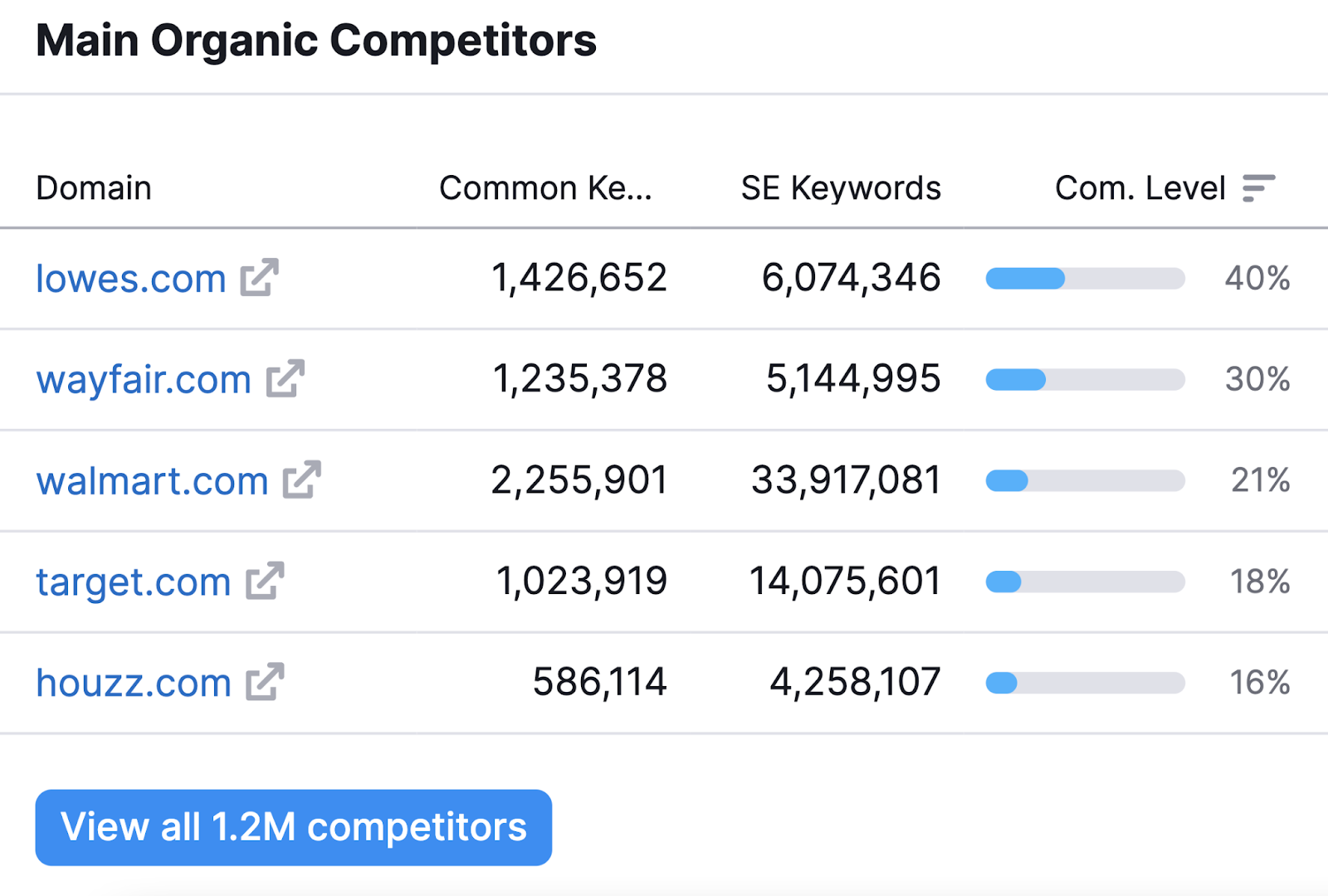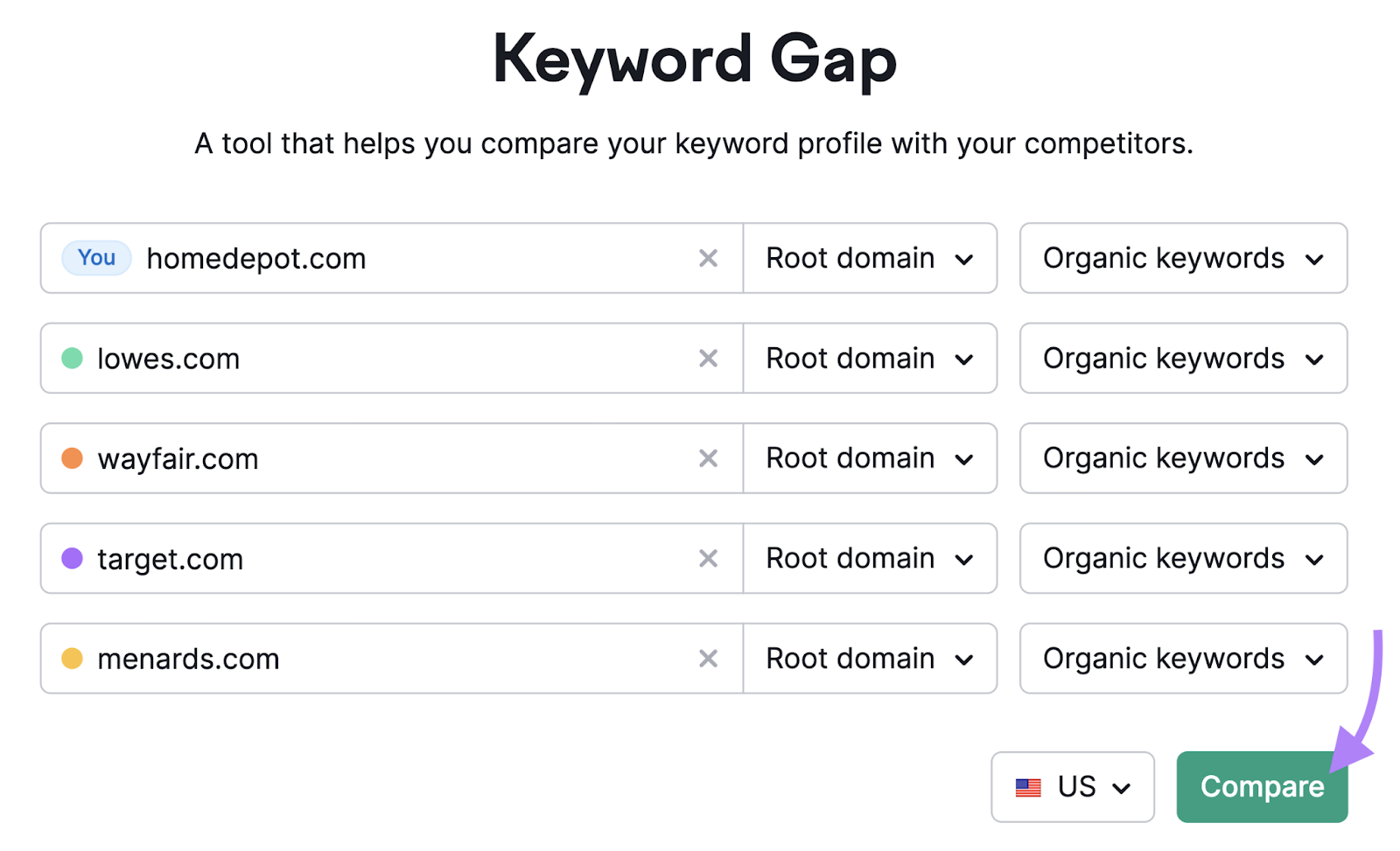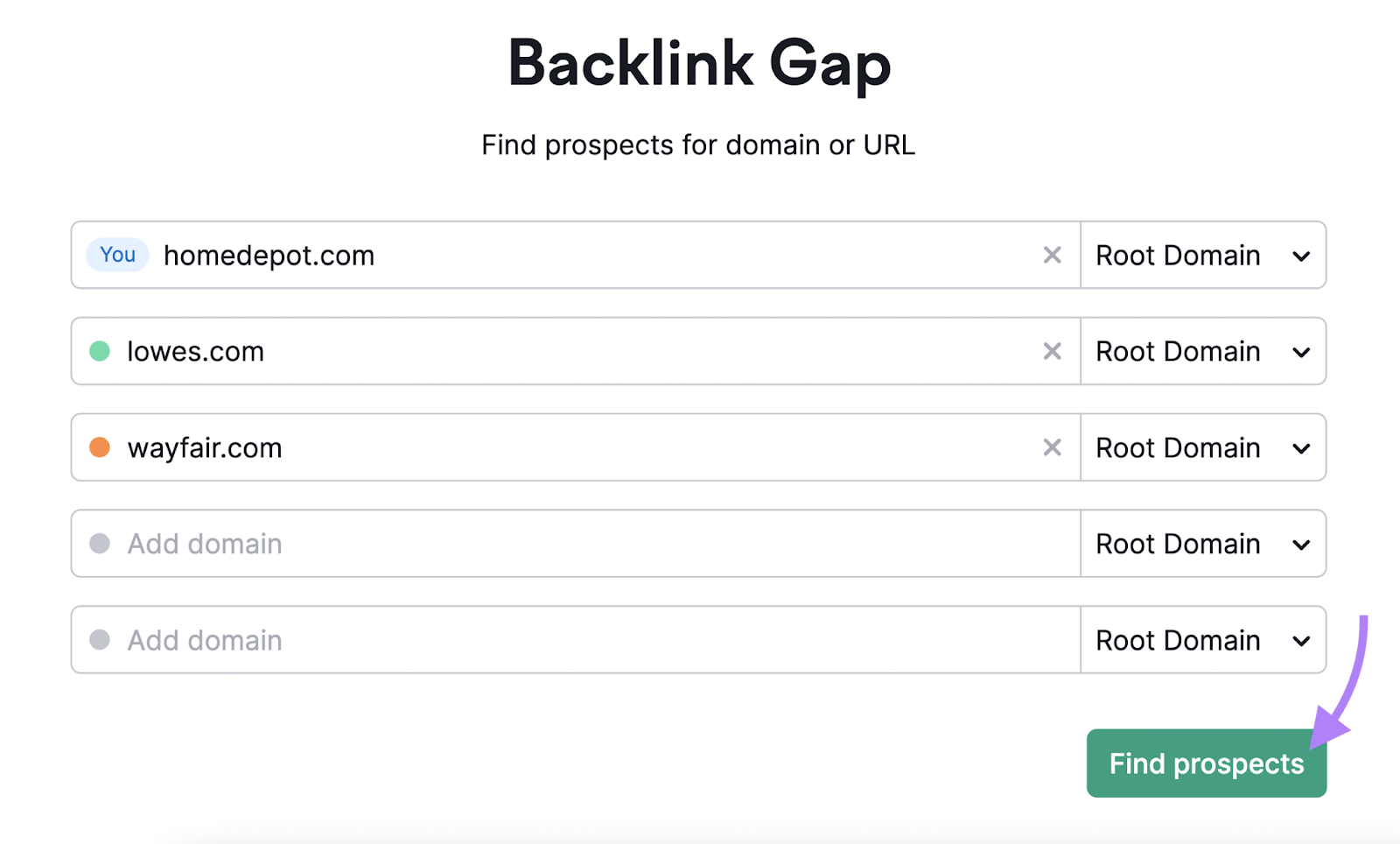Digital marketers who want to improve the SEO performance of their websites must understand the SEO Gap. Businesses can learn where they are performing poorly and identify possibilities for improvement by researching their competitors.
The SEO Gap is the distinction between a website's current SEO standing and that of its rivals. On-page optimization, backlinks, keyword rankings, and technical SEO are all included. Businesses must identify this gap to identify problems and develop a plan to close it.
Start by finding competitors in the industry who are selling comparable goods or services to the same target market to do successful competition research.
For competitor research, a variety of tools and methods are accessible, ranging from free alternatives like Google Keyword Planner and Google Trends to thorough platforms like SEMrush and Ahrefs. These tools enable organizations to examine the SEO performance, keyword plans, backlink profiles, and other factors of their rivals.
Another crucial component of competitor study is performing a thorough SEO analysis. To do this, other SEO aspects must be assessed, such as keyword usage and ranks, backlinks, on-page optimization, and technical SEO features. Businesses might find opportunities for improvement by comparing these indicators to those of rivals.
Also, another key component is analyzing the content strategy of competitors. This entails looking at the different kinds of material they provide, evaluating the engagement and quality of that content, and spotting any gaps or untapped potential.
Your businesses can discover particular possibilities and create an action plan after evaluating the SEO Gap and rival techniques. This may entail concentrating on the keywords and ranks where rival websites rank highly, putting in place a link-building plan to increase domain authority, optimizing on-page features for better visibility, and making technical SEO improvements to improve website performance.
Businesses may increase online visibility, draw more organic traffic, and improve overall SEO performance by utilizing competitor analysis to close the SEO Gap.
(1) Understanding the SEO Gap:
- The SEO Gap refers to the disparity between a website's current SEO status and its desired optimization level.
- It is crucial in digital marketing to identify areas for improvement and outperform competitors.
(2) How to Conduct Competitor Research:
- Start by identifying the main industry competitors.
- Utilize tools and techniques like keyword research and backlink analysis to gather SEO insights.
(3) Performing a Comprehensive SEO Analysis:
- Analyze keywords and rankings to identify gaps.
- Evaluate backlinks and establish a strong link-building strategy.
- Optimize on-page factors and consider technical SEO aspects.
(4) Evaluating Competitor Content Strategy:
- Examine the types of content produced by competitors.
- Assess content quality and engagement for improvement opportunities.
(5) Identifying Opportunities and Creating an Action Plan:
- Identify gaps in keywords and rankings.
- Develop a link-building strategy.
- Improve on-page optimization and implement technical SEO enhancements.
By optimizing title tags, meta descriptions, and content relevance, you may increase on-page optimization. - Implement technical SEO enhancements, such as faster site loading times, mobile friendliness, and the correction of crawl issues.
Key takeaway:
- Understanding the SEO Gap helps identify areas for improvement and outperform competitors in digital marketing.
- Conduct competitor research by identifying main competitors and using tools and techniques like keyword research and backlink analysis.
- Perform a comprehensive SEO analysis by evaluating keywords, backlinks, on-page optimization, and technical SEO factors.
- Evaluate competitor content strategy by analyzing types of content, quality, and engagement.
- Identify opportunities and create an action plan by addressing gaps in keywords, developing a link-building strategy, improving on-page optimization, and implementing technical SEO improvements.
Competitor Research : How To Beat SEO Gap
1. Understanding The SEO Gap

Way to start mitigating SEO gap
While you're not a client of an SEO agency, It's essential to have a thorough understanding of the SEO gap if you want to enhance your website's performance on search engines without help of .
The difference between your present SEO approach and that of your rivals is known as the "SEO gap." You can find weaknesses in your website and implement the necessary changes by carefully examining the SEO strategies used by your rivals.
Examining your competitors' keyword rankings is one of the first stages in figuring out the SEO gap. This study will give them important information about the keywords they are targeting and how well they are doing.
You can also see which trustworthy websites are linked to them by looking at their backlink profiles. You can use this information to find prospective web link-building opportunities for your website.
On-page optimization is a crucial component to take into account. You can learn more about how your competitors are optimizing their pages by carefully reviewing their meta tags, headings, and content structure. This assessment will also help you find any areas where your optimization efforts might be strengthened.
Analyzing your competitors' content tactics is also crucial. You can obtain ideas for captivating content that connects with your target audience by analyzing the type of material they are publishing, the frequency of their publications, and the degree of engagement they produce.
Understanding the SEO gap offers useful insights into cutting-edge techniques in your sector. It gives you the ability to make well-informed decisions that will improve your website's exposure in search engine results.
You may actively maintain a competitive edge in the online environment by constantly observing and revising your competitors' techniques. How to Use Competitive Research to Close the SEO Gap.
What is the SEO Gap?
Understanding the "SEO Gap," which is important in digital marketing, is the gap between the search engine optimization (SEO) performance of your website and that of your competitors.
You may find the SEO Gap by researching your competitors and carrying out a thorough SEO study. This entails identifying your rivals and researching their SEO approaches utilizing tools and techniques, such as examining their keyword and ranking positions, link-building strategies, on-page SEO optimization, and technical SEO considerations.
Analyzing your competitors' content strategies is crucial for improving your own. Consider the kinds of content they create, as well as the level of interest and satisfaction they inspire. This will assist you in putting together an action plan to fill in any gaps and improve your content.
You can find gaps in keywords and rankings and create a strategy to close these gaps by researching and analyzing your competitors. It might be necessary to develop a link-building plan, enhance on-page optimization, and make technical SEO enhancements.
For digital marketing to succeed, it is crucial to comprehend the SEO Gap. You can create a solid SEO plan that will provide you with a competitive edge by researching the tactics of your rivals and determining where they might be improved.
An actual corporation discovered that its biggest rival was continually gaining website visitors. They decided to look into the SEO Gap and found that their rival was performing better for important keywords.
They were able to prioritize their efforts and achieve major advancements by conducting in-depth competitor analysis and figuring out the weaknesses in their SEO strategy.
Their website's rankings and organic traffic steadily improved thanks to the use of targeted link-building tactics and optimized on-page content.
This organization was able to accomplish its digital marketing objectives and stay one step ahead of its rivals by closing the SEO Gap through competitor analysis.
Why is the SEO Gap important in digital marketing?
The SEO Gap is important in digital marketing because it helps businesses understand their competition and identify areas where they can improve their search engine optimization strategies.
By conducting competitor research and performing a comprehensive SEO analysis, businesses can gain valuable insights into the keywords and rankings that their competitors are targeting, the backlinks they have acquired, and the on-page and technical SEO factors they have optimized.
This information allows businesses to identify gaps in their SEO strategies and create an action plan to overcome them.
By understanding why the SEO Gap is important in digital marketing, businesses can identify opportunities to improve their keyword rankings, develop a link-building strategy, improve on-page optimization, and implement technical SEO improvements.
And by doing so, businesses can enhance their online visibility and attract more organic traffic to their website.
In the competitive landscape of digital marketing, having a strong SEO presence is vital for businesses to stand out and reach their target audience. By understanding the SEO Gap and leveraging competitor research, businesses can stay ahead of the competition, increase their search engine rankings, and ultimately drive more traffic and conversions.
Fact: According to a study, businesses that invest in SEO are 53% more likely to be found by potential customers compared to those who don't.
Competitor research is like spying on your competition but without the trench coat and binoculars.
2. How To Conduct Competitor Research

Way to meet the SEO gap
Unleash the power of competitor research and bridge the SEO gap! Discover how to conduct effective competitor research with this insightful section.
From pinpointing your rivals to leveraging essential tools and techniques, we'll equip you with the knowledge you need to outshine the competition. Get ready to dive into the world of competitor analysis, where data-driven insights pave the way to SEO success. Are you ready to take your digital strategy to the next level? Let's get started!
Identifying the Competitors
"Identifying the competitors is a crucial step in conducting competitor research for SEO analysis. It allows you to understand who your main competitors are and analyze their strategies to gain a competitive edge.
To identify your competitors, you need to first define your target keywords or niche. Perform a search using those keywords and analyze the top-ranking websites that appear on the search engine results page. These websites are likely your main competitors in the online space. You can use various tools and techniques to identify competitors.

Start with a SEMrush Organic Research Tool
Tools like SEMrush, SE Ranking, and Moz can provide insights into the organic and paid search competitors for your target keywords. Social media platforms can also be used to identify competitors by searching for relevant hashtags and topics related to your industry.

Determine competitors first ( Credit: SEMrush)
Once you have identified your competitors, analyze their websites, content, rankings, backlinks, and social media presence to gain insights into their SEO strategies. This analysis will help you understand their strengths and weaknesses, allowing you to develop an effective action plan to overcome the SEO gap and outperform your competitors.
Identifying the competitors is an essential step in conducting comprehensive competitor research for SEO analysis. It allows you to gain insights into your competitors' strategies, which can help you refine your SEO approach and achieve better results.
Competitor research: the spy games of the digital marketing world, where we cunningly uncover our rivals' secrets and turn them into our winning strategies."
Tools and Techniques for Competitor Research
The tools and techniques for competitor research in SEO, such as utilizing keyword research tools, conducting backlink analysis, using competitor analysis tools, monitoring social media, and analyzing content, are essential for gaining insights and staying competitive in the digital marketing landscape.
- Keyword research tools like Google Keyword Planner, SEMrush, or Ahrefs are valuable for identifying the keywords your competitors are ranking for. This helps you understand their focus and target audience.
- Backlink analysis using tools like Moz or Majestic allows you to identify the websites linking to your competitors' websites. This helps you discover potential link-building opportunities and understand competitor authority.
- Competitor analysis tools like SimilarWeb or SpyFu provide detailed information about your competitors' website traffic, organic and paid search strategies, and audience demographics. This helps you benchmark your performance and identify areas for improvement.
- Social media monitoring tools like Hootsuite or Sprout Social enable you to keep an eye on your competitors' social media channels. This allows you to track their content strategy, engagement rates, and audience sentiment.
- Content analysis tools like Buzzsumo or Clearscope help you analyze your competitors' content. This helps you identify the type of content that resonates with their audience, the keywords they are targeting, and the social shares they are receiving.
With these tools and techniques for competitor research, you can gain valuable insights into your competitors' strategies, identify gaps in your approach, and develop a more effective SEO plan to overcome the SEO gap.
Performing a comprehensive SEO analysis is like being a detective, uncovering the keywords, backlinks, on-page optimization, and technical factors that make or break your website's success.
3. Performing a Comprehensive SEO Analysis

An way to define the gaps
Performing a comprehensive SEO analysis is crucial for bridging the SEO gap and staying ahead of competitors. In this section, we'll unravel the secrets of effective keyword research and rankings, uncover the power of building strong backlinks, delve into the intricacies of on-page SEO optimization, and explore the critical role played by technical SEO factors. Prepare to unleash the potential of your website and boost its online visibility with a well-rounded SEO analysis.
Keywords and Rankings
The role of keywords and rankings is crucial in SEO. When it comes to optimizing a website, knowing and targeting the right keywords and monitoring your rankings are essential for success. Here are some important factors to consider in this regard.
1. Keyword Research: It is important to conduct thorough keyword research to identify the most relevant and high-performing keywords for your website. You can utilize tools like Google Keyword Planner or SEMrush [ Keyword gap Tool ] to discover keywords with high search volume and low competition.

Source: SEMrush
2. Targeted Optimization: Once you have identified the keywords, strategically incorporate them in meta tags, headings, content, and URLs of your website. Make sure that your website is relevant and provides valuable information related to those keywords.
3. Monitor Rankings: Regularly keep track of your website's rankings for the targeted keywords. There are various tools available, such as Google Search Console and Ahrefs, which can assist you in monitoring rankings and identifying any fluctuations or improvement opportunities.
4. Competitor Analysis: Analyze the rankings of your competitors to identify new keyword opportunities. Look for keywords they are ranking well for and consider including them in your SEO strategy.
5. Continuous Optimization: SEO is an ongoing process, and rankings can change over time. Continuously analyze and optimize your website based on the performance of your keywords and rankings. Keep an eye on your competitors' strategies and make necessary adaptations.
By focusing on keywords and rankings, you can enhance the visibility of your website in search engines and attract more organic traffic. Remember, staying updated with the latest SEO trends and continuously refining your optimization efforts is key to achieving and maintaining high rankings.
Building strong backlinks is like assembling a highly persuasive army, ready to conquer search engine rankings and leave your competitors running for cover.
Backlinks and Link Building
Before going to the backlink building, let you know what are the exact gap between you and your competitors.

Source: SEMrush
So, when it comes to improving your website's SEO, backlinks and link building play a crucial role. Here are some key points to consider:
- Backlinks and link building are external links that direct users to your website from other websites. They are important because search engines like Google consider them as a signal of trust and authority. The more high-quality backlinks and link-building your website has, the higher it will rank in search engine results.
- Link building refers to the process of acquiring these backlinks and link building. It involves reaching out to other websites, creating valuable content, and fostering relationships with influencers in your industry to generate organic backlinks and link-building.
- Quality matters more than quantity when it comes to backlinks and link building. Focus on obtaining links from reputable websites that have relevant content and a high domain authority.
- Guest posting on other websites is an effective way to build backlinks and link building. By providing valuable content to other sites, you can include a link back to your website, driving traffic and improving SEO.
- Ensure that your backlink and link-building profile appears natural and diverse. A healthy mix of different types of links, such as editorial links, directory links, and social media links, will help boost your website's SEO performance.
- Regularly monitor your backlinks and link building to identify any broken or spammy links. It's important to disavow low-quality or irrelevant backlinks and link building to maintain a clean and high-quality backlink profile.
- Don't forget to optimize your internal linking structure as well. Linking relevant pages within your website helps search engines understand the hierarchy and importance of your content.
By implementing a solid backlink and link-building strategy and consistently building quality links, you can improve your website's visibility and rankings in search engine results.
On-Page SEO Optimization
On-Page SEO is a crucial aspect of digital marketing. It involves optimizing the elements on a website to improve its visibility and ranking in search engine results pages. To achieve effective -
- Ensure that your website's content includes relevant keywords that are strategically placed throughout the page. This helps search engines understand the content and improve its visibility for relevant searches.
- Optimize the title tags and meta descriptions of your web pages with targeted keywords. This will help search engines and users understand the content and relevance of your page.
- Pay attention to the structure of your website's URLs. Use descriptive and keyword-rich URLs that are easily readable by both search engines and users.
- Create high-quality and engaging content that provides value to your audience. This can include informative articles, how-to guides, videos, and infographics.
- Optimize your website's images by using descriptive filenames and adding alt text. This helps search engines understand the content of the images and improves their visibility in image search results.
- Improve the overall user experience by making your website mobile-friendly, optimizing page loading speed, and ensuring easy navigation.
- Implement proper heading tags (H1, H2, H3, etc.) to structure your content and make it more readable for both users and search engines.
By implementing these On-Page SEO Optimization techniques, you can enhance your website's visibility, attract more organic traffic, and improve your overall search engine ranking. Consider these strategies to ensure your website's success in the competitive digital landscape.
Technical SEO Factors: Where coding meets chaos and the search engines put on their detective hats to decipher your website's secrets.
Technical SEO Factors
Technical SEO factors, such as website speed, mobile friendliness, site structure, XML sitemap, schema markup, and canonical tags, play a crucial role in optimizing a website for search engines. These factors directly impact a website's visibility and ranking in search engine results.
Fast loading times are essential for user experience and search engine rankings. Therefore, website owners should optimize their websites for quick loading by compressing images, minifying CSS and JavaScript, and utilizing caching techniques.
With the majority of internet users accessing websites from mobile devices, it's crucial to ensure that a website is mobile-friendly. This includes responsive design, easy navigation, and optimized content for mobile screens.
A well-organized site structure helps search engines understand the hierarchy and relevance of the website's pages. It involves a clear URL structure, logical navigation, and proper use of header tags (H1, H2, etc.).
To help search engines crawl and index a website more efficiently, website owners should provide an XML sitemap. An XML sitemap acts as a roadmap of all the pages on the site, ensuring that no important content is missed.
Implementing schema markup helps search engines better understand the content on a website. Schema markup adds additional context to the information, enhancing the chances of appearing in rich snippets and improving click-through rates.
Canonical tags are used to indicate the preferred version of a webpage when there is duplicate or similar content across multiple URLs. This prevents duplicate content issues and ensures search engines are indexing the correct page.
By focusing on these technical SEO factors, website owners can improve their website's performance, user experience, and search engine rankings. It's essential to regularly monitor and optimize these aspects to stay competitive in the digital landscape.
When implementing technical SEO factors, ensure that the website loads quickly is mobile-friendly, has a clear site structure, includes an XML sitemap, utilizes schema markup, and implements canonical tags. Following these practices will improve the website's visibility and ranking in search engine results.
4. Evaluating Competitor Content Strategy

Content type, style, and quality gap matters
Looking to outshine your competitors in the SEO game? In this section, we'll dig deep into the world of evaluating competitor content strategy.
Discover the various types of content they're leveraging and how they affect their performance, as well as the crucial aspects of content quality and engagement. Get ready to unlock insights that will help you bridge the SEO gap and position yourself ahead of the competition. Let's dive in!
Types of content
Types of content play a crucial role in digital marketing. Here are some common types of content that businesses use to engage their audience and drive traffic to their websites:
1. Blog Posts: Companies often use blog posts to provide informational and educational content to their audience. Blog posts are effective in boosting website rankings and attracting organic traffic.
2. Videos: Visual content, such as videos, has become increasingly popular in recent years. Videos can be used for product demonstrations, tutorials, interviews, and engaging storytelling. They help businesses to convey their message more effectively and create a deeper connection with their audience.
3. Infographics: Infographics are visually appealing and informative graphics that present complex information in a visually digestible format. They are highly shareable on social media platforms and are effective in increasing brand visibility and driving traffic.
4. Whitepapers and eBooks: These in-depth and comprehensive documents provide valuable insights and thought leadership on specific topics. They are often used in B2B marketing to establish credibility and generate leads.
5. Case Studies: Case studies showcase the success stories of a business and how their products or services have helped their customers. They provide real-life examples of how a company has addressed specific challenges and can influence potential customers' decision-making process.
Fact: According to a survey, 72% of marketers believe that content marketing increases engagement and leads to higher conversions.
Content quality and engagement
When it comes to SEO, content quality and engagement are paramount in driving traffic and improving search engine rankings. The significance of high-quality content that is relevant, informative, and engaging cannot be underestimated.
Such content has the potential to attract a larger number of visitors to your website and encourage them to stay longer, explore additional pages, and take desired actions.
To ensure content quality and engagement, it is crucial to create well-written, error-free, and unique content that resonates with your target audience. One effective strategy is to utilize descriptive headings and subheadings, incorporate relevant keywords naturally, and ensure that the content is easy to read and understand.
Engagement can be enhanced through the inclusion of interactive elements such as videos, images, infographics, and interactive quizzes. Additionally, it is beneficial to encourage user-generated content by inviting comments, reviews, and social media sharing.
Building a sense of community and establishing trust can be fostered by promptly responding to comments and actively engaging with your audience.
Measuring content engagement is crucial for identifying successful strategies and areas that require improvement. Analyzing metrics such as bounce rate, time on page, click-through rates, and social shares can provide insights into audience engagement and guide data-driven improvements.
It is essential to regularly update and optimize your content based on user feedback and changing trends to ensure its freshness and relevance.
Here's a true story that exemplifies the impact of content quality and engagement: A company facing low website traffic discovered that its content lacked engagement.
However, after revamping their blog posts by incorporating interactive elements and incorporating user feedback, they witnessed a remarkable 50% increase in organic traffic and a significant boost in user engagement.
This experience taught the company the invaluable importance of content quality and engagement in attracting and retaining its target audience.
It's time to put on your detective hat and uncover the hidden opportunities in the vast jungle of SEO.
5. Identifying Opportunities and Creating an Action Plan

With keywords gap, link-building, on-page SEO and technical SEO enhancement
Uncover new avenues for SEO success with competitor research in the section on identifying and seizing opportunities.
From discovering gaps in keywords and rankings to devising effective link-building strategies, enhancing on-page optimization, and implementing technical SEO improvements, this section will equip you with actionable insights to bridge the SEO gap and elevate your digital presence.
Identifying gaps in keywords and rankings
Identifying gaps in keywords and rankings is a crucial step in SEO analysis. By understanding where your competitors are ranking for specific keywords that are relevant to your industry, you can uncover opportunities for improvement and develop a strategy to outrank them.
- Conduct keyword research: Start by identifying the keywords that are important for your business. Use tools like Google Keyword Planner or SEMrush to find relevant keywords that have high search volume and are aligned with your target audience.
- Analyze competitor rankings: Look at your competitors' websites and analyze their rankings for the chosen keywords. Identify the gaps where your competitors are ranking higher than you.
- Identify keyword opportunities: Find keywords where your competitors are not ranking well, but have high search volume and relevance to your business. These are the keyword gaps that you can target to improve your rankings.
- Assess your content: Review your existing content and optimize it to target the identified keywords. Ensure that your content is well-optimized, informative, and engaging to boost your rankings.
- Create a content strategy: Develop a content strategy that focuses on filling the gaps in keywords and rankings. Create new, high-quality content that targets the identified keywords and provides value to your audience.
- Monitor progress: Regularly track your rankings and compare them with your competitors. Use SEO tools like Moz or Ahrefs to monitor keyword rankings and identify any changes or improvements over time.
By consistently identifying and targeting the gaps in keywords and rankings, you can improve your website's visibility, attract more organic traffic, and stay ahead of your competitors in the search engine results pages.
Building strong links is like building friendships but with more keywords and fewer friendship bracelets.
Developing a link-building strategy
Developing a link-building strategy is crucial for improving your website's visibility and search engine rankings. Here are some key steps to consider when it comes to developing a link-building strategy:
- Identify relevant websites: Research and identify websites that are related to your industry or niche. Look for websites that have a high domain authority and a good reputation.
- Create valuable content: Developing a link-building strategy involves developing high-quality content that provides value to your target audience. This can be in the form of blog posts, articles, infographics, or videos.
- Reach out to website owners: Contact the owners of the identified websites and offer your valuable content for them to feature on their site. Make sure to personalize your outreach and explain why your content would be a valuable addition to their site.
- Guest posting: Consider writing guest posts for reputable websites within your niche. This allows you to showcase your expertise while gaining backlinks to your site. Remember to follow the guidelines provided by the website for guest posting.
- Engage in social media promotion: Use social media platforms to promote your content and engage with influencers in your industry. Building relationships with influencers can lead to opportunities for collaborations and backlinks.
Remember, developing a link-building strategy should always focus on providing value to both your website and the websites you are reaching out to. By developing a strategic link-building strategy, you can increase your website's authority and improve your search engine rankings.
Incorporating a well-planned link-building strategy into your overall digital marketing efforts can greatly enhance your website's visibility and increase organic traffic.
Improving on-page optimization
On-page optimization is crucial for enhancing a website's search engine rankings and overall visibility. Here are some key strategies to consider:
- Keyword optimization: Identify relevant keywords and naturally incorporate them into the page title, headings, meta descriptions, and content to improve on-page optimization.
- Content quality: Create unique, high-quality content that provides value to the readers. Focus on delivering informative and engaging content that satisfies user intent and contributes to improving on-page optimization.
- URL structure: Ensure that the URLs are descriptive and include relevant keywords. Use hyphens to separate words and make it easy for both users and search engines to understand the page's content, thereby enhancing on-page optimization.
- Optimized meta tags: Craft compelling meta titles and descriptions that accurately represent the page's content. Include relevant keywords to entice users to click on the search results for improved on-page optimization.
- Internal linking: Utilize internal links to connect relevant pages within your website. This helps search engines understand the website's structure and distributes link equity throughout the site, further enhancing on-page optimization.
- Image optimization: Optimize images by using descriptive filenames, and alt tags, and compressing them to improve page load speed. This helps with both user experience and search engine optimization, contributing to on-page optimization.
- Mobile optimization: Ensure that your website is fully optimized for mobile devices. This includes using a responsive design, optimizing page speed, and providing a seamless user experience on mobile devices, which is essential for on-page optimization.
Fact: According to a study by Backlinko, pages that load in less than 2 seconds have an average bounce rate of 9%.
Implementing technical SEO improvements
Implementing technical SEO improvements plays a crucial role in bridging the SEO gap and enhancing the performance of your website. Here are the steps to effectively incorporate these improvements:
- Conduct a comprehensive technical SEO audit to identify any existing issues or areas for enhancement.
- Enhance your website's loading speed by compressing images, minifying CSS and JavaScript files, and enabling browser caching.
- Ensure proper indexing by submitting an XML sitemap to search engines and optimizing your robots.txt file.
- Rectify any broken links or redirects to improve user experience and maintain a healthy link structure.
- Implement schema markup to provide search engines with structured data and improve the visibility of your website in search results.
- Optimize your website for mobile devices by ensuring a responsive design, optimizing page loading speed, and incorporating mobile-friendly features.
- Improve website security by implementing HTTPS encryption and regularly updating security measures.
- Optimize meta tags, title tags, and header tags to enhance keyword relevance and click-through rates in search results.
- Create a user-friendly URL structure that is descriptive and contains relevant keywords.
By incorporating these technical SEO improvements, you can enhance the visibility and performance of your website, attract more organic traffic, and ultimately achieve higher rankings in search engine results.
Last Thoughts
In conclusion, Businesses looking to succeed in the digital sphere would benefit greatly from mastering the skill of closing the SEO gap through competitive analysis. The key takeaways from this exploration of competitive SEO analysis highlight its significance:
- Winning Strategies and Weaknesses: Competitive SEO analysis unveils the strategies that are propelling your competitors to success, while also shedding light on their vulnerabilities. This invaluable insight equips businesses with the knowledge needed to make strategic decisions.
- Keyword Discovery and Content Innovation: By delving into your competitors' keyword targeting, a treasure trove of new keywords and content ideas becomes accessible. This not only enriches your content strategy but also enhances your SEO approach.
- Benchmarking SEO Performance: SEO competitor analysis offers a yardstick to measure your website's SEO performance against that of your rivals. This benchmarking process helps you gauge your strengths and areas for improvement.
- Unearthing Link-Building Opportunities: Understanding the competitive landscape in SEO unveils a plethora of link-building opportunities. These opportunities can boost your website's authority and visibility, a crucial element in the SEO game.
- Identifying Competitors and Ranking Keywords: The journey to a successful SEO competitive analysis begins with identifying your competitors and the keywords they rank for. This foundational step sets the stage for a comprehensive exploration of the digital battlefield.
In essence, any company looking to succeed in the fiercely competitive internet market must strategically depend on closing the SEO gap through competitor analysis. With these insights at your disposal, you have the means to not only keep up with but also surpass your rivals, staking your claim to the digital kingdom in the process.

